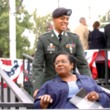Miles to Go for Freedom: Segregation and Civil Rights in the Jim Crow Years.
(Book)
J 305.896 OSBOR
1 available
Copies
| Location | Call Number | Status |
|---|---|---|
| Central - Kids Nonfiction | J 305.896 OSBOR | Available |
Description
“A detailed and thought-provoking account of segregation” including photos and first-person stories illustrating life in the Jim Crow era (Publishers Weekly, starred review).
Told through unforgettable first-person accounts, photographs, and other primary sources, this book is an overview of racial segregation and early civil rights efforts in the United States from the 1890s to 1954, a period known as the Jim Crow years. Multiple perspectives are examined as the book looks at the impact of legal segregation and discrimination on the day-to-day life of black and white Americans across the country. Complete with a bibliography and an index, it is both an engrossing read and an important addition to black history books for young people.
“A valuable and comprehensive perspective on American race relations.” —Publishers Weekly (starred review)
“Readers will come away moved, saddened, troubled by this stain on their country’s past and filled with abiding respect for those who fought and overcame. Osborne expertly guides readers through this painful, turbulent time of segregation, enabling them to understand fully the victims’ struggles and triumphs as they worked courageously to set things right.” —Kirkus Reviews (starred review)
“The text is elegant and understated. Drawing on personal interviews, the author provides incidents of everyday racism that young people will be able to grasp and relate to immediately.” —School Library Journal (starred review)
“Tight, consistent focus, pristine organization, and eminently browsable illustrations make this middle-school offering a strong recommendation.” —Bulletin of the Center for Children’s Books
“A well-written chronicle of the African-American struggle for equal rights in the United States. The reader will be quickly engaged.” —Library Media Connection
More Details
Notes
Subjects
African Americans -- Segregation -- History -- 20th century -- Juvenile literature.
Civil rights movements -- United States -- History -- 20th century -- Juvenile literature.
United States -- Race relations -- Juvenile literature.
Also in this Series
Published Reviews
Booklist Review
*Starred Review* In this companion volume to Traveling the Freedom Road (2009), Osborne once again offers a handsome, highly readable overview of African American history, focusing here on both the South and the North during the late nineteenth century through the mid-twentieth century. Drawing on her work as a senior editor at the Library of Congress, Osborne bolsters her gripping account with many quotes from primary sources, including interviews with those who were young during the time period covered. The history and politics are brought home by the moving personal stories, which show that separate is not equal and demonstrate how the laws written and unwritten resulted in widespread discrimination, cruel prejudice, and humiliation. Period photos, including public events, such as a teen lynching; magazine illustrations; and prints fill every double-page spread. After the first section on the South, the following section about the North focuses on the Great Migration, exploring not only the reasons why African Americans left but also the often chilly reception they received when they arrived. The final short section about the nation as a whole ends with the triumph of Brown v. Board of Education, which opened the way for the civil rights movement. Spacious back matter includes a time line, extensive notes, and a bibliography. A must for classroom discussion and research.--Rochman, Hazel Copyright 2010 Booklist
Publisher's Weekly Review
Osborne continues her chronological exploration of the racial history of the United States, following Traveling the Freedom Road (2009) with a detailed and thought-provoking account of segregation, with specific focus on the tumultuous years between the 1896 Plessy v. Ferguson decision (which came to establish the idea of "separate but equal") and Brown v. Board of Education in 1954. Osborne writtes that for the two decades following the passage of the 14th and 15th Amendments, "disfranchisement (not being allowed to vote) and rigid legal segregation did not exist." Nevertheless, she explains, concerted efforts by Southern states led to the establishment of voting literacy tests and other changes to state-level voting laws, which aimed to counteract the gains made during Reconstruction, as well as the Jim Crow laws, which separated blacks and whites both physically and psychologically. Published in association with the Library of Congress, the book offers numerous captivating b&w photographs, first-person accounts of horrific violence and dehumanization, and descriptions of individual and collective defiance. A valuable and comprehensive perspective on American race relations. Ages 10-14. (Feb.)? (c) Copyright PWxyz, LLC. All rights reserved.
School Library Journal Review
Gr 6-10-This companion to Osborne's Traveling the Freedom Road: From Slavery and the Civil War Through Reconstruction (Abrams, 2009) painstakingly documents a period of "widespread discrimination, cruel prejudice and daily humiliation" from the late 19th to mid-20th century. The book showcases pieces from the Library of Congress's African-American history collection, including photographs, drawings, and documents. Each page is laid out in a restrained scrapbook style with dynamic black-and-white photos and reproductions offset by jewel-toned frames. The text is elegant and understated. Drawing on personal interviews, the author provides incidents of everyday racism that young people will be able to grasp and relate to immediately. One man recalls growing up in North Carolina, where African Americans were served hot dogs through a 12-inch hole in a wall at the back of a restaurant rather than served face-to-face. One striking photograph shows a man in profile climbing steep stairs to a separate "colored" entrance to a movie theater, while another depicts a burned-out, broken-down school bus for black children. A letter from 1926 contains a one-sentence letter: "I am sorry, but no colored students are accepted at the Peabody University." Osborne's archival and storytelling talents are equally powerful. Her clear-sighted narrative does not hold back from exposing cruelty, but she never lets sorrow overwhelm it.-Jess deCourcy Hinds, Bard H.S. Early College, Queens, NY (c) Copyright 2012. Library Journals LLC, a wholly owned subsidiary of Media Source, Inc. No redistribution permitted.
Horn Book Review
This companion to Traveling the Freedom Road offers an in-depth history of the Jim Crow years, from Plessy v. Ferguson (1896) through Brown v. Board of Education (1954). The well-written, readable volume is at its best in demonstrating the precursors ushered in during the civil rights movement of the 1960s. Photographs are well chosen and superb. (c) Copyright 2012. The Horn Book, Inc., a wholly owned subsidiary of Media Source, Inc. No redistribution permitted.
Kirkus Book Review
Copyright Kirkus Reviews, used with permission.
Booklist Reviews
*Starred Review* In this companion volume to Traveling the Freedom Road (2009), Osborne once again offers a handsome, highly readable overview of African American history, focusing here on both the South and the North during the late nineteenth century through the mid-twentieth century. Drawing on her work as a senior editor at the Library of Congress, Osborne bolsters her gripping account with many quotes from primary sources, including interviews with those who were young during the time period covered. The history and politics are brought home by the moving personal stories, which show that separate is not equal and demonstrate how the laws—written and unwritten—resulted in widespread discrimination, cruel prejudice, and humiliation. Period photos, including public events, such as a teen lynching; magazine illustrations; and prints fill every double-page spread. After the first section on the South, the following section about the North focuses on the Great Migration, exploring not only the reasons why African Americans left but also the often chilly reception they received when they arrived. The final short section about the nation as a whole ends with the triumph of Brown v. Board of Education, which opened the way for the civil rights movement. Spacious back matter includes a time line, extensive notes, and a bibliography. A must for classroom discussion and research. Copyright 2012 Booklist Reviews.
Library Journal Reviews
As a native Pacific Northwesterner, I felt some geographic and historical distance from the more egregious offenses of the Jim Crow laws—that is, until I read this well-researched and beautifully presented account of the history and impact of segregation. For herein, I learned that even what is now a progressive Seattle neighborhood issued a covenant in 1927 agreeing that property owners would not allow "Negroes or any person of negro blood" to occupy, buy, lease, or rent a home. Beginning with the Supreme Court's "separate but equal" ruling, Plessy v. Ferguson, laws like this one were common throughout the South, the North, and on a national scale (as in the military). It took another Supreme Court ruling, 1954's Brown v. Board of Education, to open access for all and make stories like Charlayne Hunter Gault's (above) possible. Published in association with the Library of Congress, Osborne's book is a beautiful addition in a year rich with Civil Rights era offerings. (c) Copyright 2011. Library Journals LLC, a wholly owned subsidiary of Media Source, Inc. No redistribution permitted.
Publishers Weekly Reviews
Osborne continues her chronological exploration of the racial history of the United States, following Traveling the Freedom Road (2009) with a detailed and thought-provoking account of segregation, with specific focus on the tumultuous years between the 1896 Plessy v. Ferguson decision (which came to establish the idea of "separate but equal") and Brown v. Board of Education in 1954. Osborne writtes that for the two decades following the passage of the 14th and 15th Amendments, "disfranchisement (not being allowed to vote) and rigid legal segregation did not exist." Nevertheless, she explains, concerted efforts by Southern states led to the establishment of voting literacy tests and other changes to state-level voting laws, which aimed to counteract the gains made during Reconstruction, as well as the Jim Crow laws, which separated blacks and whites both physically and psychologically. Published in association with the Library of Congress, the book offers numerous captivating b&w photographs, first-person accounts of horrific violence and dehumanization, and descriptions of individual and collective defiance. A valuable and comprehensive perspective on American race relations. Ages 10–14. (Feb.)¦
[Page ]. Copyright 2011 PWxyz LLCSchool Library Journal Reviews
Gr 6–10—This companion to Osborne's Traveling the Freedom Road: From Slavery and the Civil War Through Reconstruction (Abrams, 2009) painstakingly documents a period of "widespread discrimination, cruel prejudice and daily humiliation" from the late 19th to mid-20th century. The book showcases pieces from the Library of Congress's African-American history collection, including photographs, drawings, and documents. Each page is laid out in a restrained scrapbook style with dynamic black-and-white photos and reproductions offset by jewel-toned frames. The text is elegant and understated. Drawing on personal interviews, the author provides incidents of everyday racism that young people will be able to grasp and relate to immediately. One man recalls growing up in North Carolina, where African Americans were served hot dogs through a 12-inch hole in a wall at the back of a restaurant rather than served face-to-face. One striking photograph shows a man in profile climbing steep stairs to a separate "colored" entrance to a movie theater, while another depicts a burned-out, broken-down school bus for black children. A letter from 1926 contains a one-sentence letter: "I am sorry, but no colored students are accepted at the Peabody University." Osborne's archival and storytelling talents are equally powerful. Her clear-sighted narrative does not hold back from exposing cruelty, but she never lets sorrow overwhelm it.—Jess deCourcy Hinds, Bard H.S. Early College, Queens, NY
[Page 142]. (c) Copyright 2011. Library Journals LLC, a wholly owned subsidiary of Media Source, Inc. No redistribution permitted.Reviews from GoodReads
Citations
Osborne, L. B. (2012). Miles to Go for Freedom: Segregation and Civil Rights in the Jim Crow Years . Abrams Books for Young Readers.
Chicago / Turabian - Author Date Citation, 17th Edition (style guide)Osborne, Linda Barrett. 2012. Miles to Go for Freedom: Segregation and Civil Rights in the Jim Crow Years. New York, NY: Abrams Books for Young Readers.
Chicago / Turabian - Humanities (Notes and Bibliography) Citation, 17th Edition (style guide)Osborne, Linda Barrett. Miles to Go for Freedom: Segregation and Civil Rights in the Jim Crow Years New York, NY: Abrams Books for Young Readers, 2012.
Harvard Citation (style guide)Osborne, L. B. (2012). Miles to go for freedom: segregation and civil rights in the jim crow years. New York, NY: Abrams Books for Young Readers.
MLA Citation, 9th Edition (style guide)Osborne, Linda Barrett. Miles to Go for Freedom: Segregation and Civil Rights in the Jim Crow Years Abrams Books for Young Readers, 2012.
































